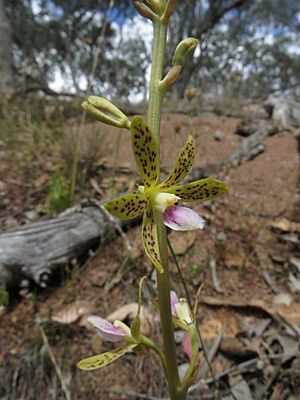Yellow hyacinth-orchid facts for kids
Quick facts for kids Yellow hyacinth-orchid |
|
|---|---|
 |
|
| Dipodium hamiltonianum in East Gippsland | |
| Scientific classification | |
| Genus: |
Dipodium
|
| Species: |
hamiltonianum
|
The Dipodium hamiltonianum, commonly called the yellow hyacinth-orchid, is a unique plant found only in eastern Australia. This orchid is special because it doesn't have leaves and gets its food from fungi in the soil. It can grow up to 25 greenish flowers with dark red spots on a tall stem.
Contents
Discover the Yellow Hyacinth-Orchid
Most of the year, the yellow hyacinth-orchid stays hidden underground. It has thick, fleshy roots that store energy. From November to March, tall flower spikes pop up from the ground. These spikes can be between 40 and 80 centimeters tall!
Each spike holds 3 to 25 yellow or greenish-yellow flowers. These flowers are a bit fleshy and have red or purple spots. The bottom petal, called the labellum, sticks out and is white with purple marks. It also has a small tuft of white hairs. Usually, each plant only sends up one flower spike at a time. Sometimes, a plant might only flower once every five years!
Naming the Yellow Hyacinth-Orchid
This orchid was first officially described in 1881 by a botanist named Frederick Manson Bailey. He found the plant material on Stradbroke Island and Peel Island near Brisbane, Australia.
Later, in 1913, Bailey changed his mind and decided it was just a type of another orchid, Dipodium punctatum. But in 1944, another botanist and orchid expert, Herman Rupp, said it was its own special species again. The orchid is named after James Hamilton, who helped collect plants for Bailey.
Where the Yellow Hyacinth-Orchid Lives
You can find the yellow hyacinth-orchid in eastern Australia, from central Queensland down through New South Wales and the Australian Capital Territory to eastern Victoria. It grows from sea level up to 800 meters high.
Orchids in Queensland
In Queensland, this orchid grows south from the Theodore area. In tropical places, it likes grassy areas near streams. Along the coast, it lives in scrub and heathland. For example, at Noosa Heads, it has been seen growing in special sandy woodlands and dry heath.
Orchids in New South Wales
In New South Wales, the orchid is found on dry western slopes with sandy soils. It can be seen as far west as the Parkes area. You can also find it on sandy soils at the southern end of Seven Mile Beach National Park on the south coast. It also grows in the Australian Capital Territory.
Orchids in Victoria
In north-eastern Victoria, seven groups of these orchids have been found growing in open forests, often among granite rocks. Four of these groups are near Beechworth, one is in Burrowa-Pine Mountain National Park, one in Chiltern Regional Park, and another on private land near Chesney Vale.
Some of the trees that grow near these orchids include red stringybark (Eucalyptus macrorhyncha), red box (Eucalyptus polyanthemos), and black cypress-pine (Callitris endlicheri). Other small plants found with them include daphne heath (Brachyloma daphnoides) and flat-leaf bush-pea (Pultenaea platyphylla).
Two more groups of orchids are near Wulgulmerang in East Gippsland, where white box (Eucalyptus albens) trees are common. In Victoria, these orchids usually flower from December to January. They prefer dry, well-drained slopes that face north and have granite soils.
How the Orchid Interacts with Nature
Scientists think that small native bees or wasps might help pollinate the yellow hyacinth-orchid's flowers. Sometimes, wallabies, like the black wallaby (Wallabia bicolor), might accidentally cut off the flower spikes while grazing, but they don't eat them.
Protecting the Yellow Hyacinth-Orchid
Researchers are studying what the yellow hyacinth-orchid needs to grow well. This helps them protect the orchid in its natural home and also learn how to grow it in special gardens. They found that the orchid mostly connects with two types of fungi called Gymnomyces and Russula. These fungi often grow with eucalyptus trees in Australia, but the study didn't find one specific tree that the orchid prefers.
The yellow hyacinth-orchid is listed as "threatened" in Victoria under a law called the Flora and Fauna Guarantee Act 1988. It's also on a special list of rare or threatened plants in Victoria. In 1997, there were only 105 of these plants recorded in Victoria, spread across 9 different places.
Growing the Yellow Hyacinth-Orchid
So far, it has been very hard to grow this orchid outside of its natural home. It's also difficult to move it successfully. This is because we haven't figured out how to perfectly copy its special connection with the fungi it needs to survive in a garden setting.

